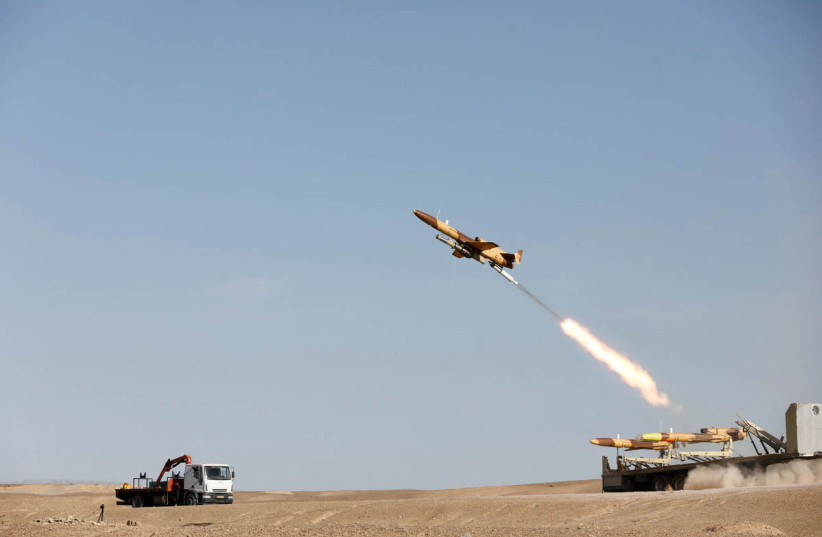Iran’s advanced armament leaves Hamas’s rocket system in the dust
Three days after the Iranian missile attack on Israel and the successful interception of the vast majority of them, the defense establishment and the defense industry are now engaged in investigating the incident and learning from the events.
Although Israel has been successfully intercepting rockets launched from Gaza since the Iron Dome’s conception in 2011, and the Rafael system has recorded thousands of successful interceptions, the attack in the early hours of last Sunday was on a scale that no country has faced to date, and with Iranian missiles, some of which were used operationally for the first time.
“This was the first time that precision Iranian missiles were us against Israel in an operation, in the largest ballistic and cruise missile attack ever recorded,” says Tal Inbar, an expert on the Iranian missile program. “Not even the Russian missile barrage against Ukraine reached these dimensions. By intercepting the missiles through cooperation with foreign countries, we saw the implementation of capabilities and joint operational language developed in the Iron Shield Operation conducted by Israel and the US, with a most impressive success.”
Alongside the rocket barrages launched by Hamas from Lebanon and intercepted by Iron Dome, Iran used three types of advanced missiles it developed.
Types of missiles Iran used for the attack
The Shahed 238 is a canister version of the Shahed 136 that Iran sold to Russia and has been used for targeting Ukraine. The 238 is equipped with a small canister engine that allows it to cruise at twice the speed, close to 600 km/h, instead of about 180 km/h for rocket-propelled missiles. According to reports, Iran launched around 170-180 drones and around 30 such cruise missiles towards Israel.

The higher speed reduces the time available for the targeted force to intercept it and for fighter jets to reach it. However, when the fighter jet is already close, interception becomes easier because the canister engine generates more heat, which makes it easier for air-to-air missiles to locate and hit it, which is what happened when these devices were intercepted outside Israel’s borders by Israeli, American, British, French, and Jordanian fighter jets in one of their first operational actions.
Its warhead weighs approximately 40 kg, slightly less than Hamas’s long-range rocket, the R160. The Shahed is more precise in hitting its target, although GPS disruptions can affect its accuracy.
Paveh 351 is a long-range jet cruise missile, heavier and faster than the Shahed 238 that Iran unveiled just last year. The Hapawa reaches a range of about 1,650 km and cruises at a speed of about 800 km/h. Iran launched approximately 30 such missiles at Israel, similar to those used in the past to attack Saudi oil facilities. They, too, were intercepted on their way to Israel, apparently by a David slingshot system made by Rafael that was developed against such threats.
The attack was the first operational use of the new Iranian ballistic missile, the Emad, which was also introduced just last year. The main innovation of this missile is that it is a maneuverable missile: it does not fly on a predetermined ballistic trajectory at the time of launch. Still, it can maneuver after entering the atmosphere to deceive missile defense systems tracking it and interceptor missiles launched to intercept it.
Emad, with a range of about 1,700 km, permits Iran to launch missiles at Israel from deep within its territory. It is powered by liquid fuel. Its warhead is also significantly larger than that of cruise missiles and heavy rockets fired at Israel so far: 750 kg, compared to about 500 kg, the weight of the Iranian Fateh 110 also held by Hezbollah or 20 kg of a BM-21 “Grad” rocket. In addition, Iran also launched Shahab-3 ballistic missiles.
A department within the Defense Ministry and the aerospace industry adapted Arrow-2 during upgrades carried out over the years to deal with maneuvering ballistic missiles.
Arrow-3, which intercepts at a higher altitude in space, can destroy them even before they begin maneuvering.
Currently, despite the successful interceptions by Arrow and several RIM-161 Standard missiles launched from American destroyers, several hits were still recorded in the southern part of the country. This primarily serves as further evidence that achieving a 100% interception success rate is difficult, as is the case with the Iron Dome system, and that the initial announcement by an IDF spokesperson regarding a 99% success rate was somewhat optimistic.





Comments are closed.